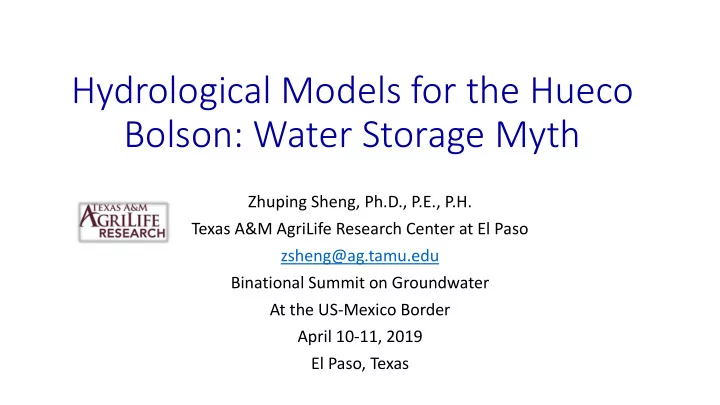

Hydrological Models for the Hueco Bolson: Water Storage Myth Zhuping Sheng, Ph.D., P.E., P.H. Texas A&M AgriLife Research Center at El Paso zsheng@ag.tamu.edu Binational Summit on Groundwater At the US-Mexico Border April 10-11, 2019 El Paso, Texas
Acknowledgement • U.S. Geological Survey TAAP (TWRI: John Tracy, Rosario Sanchez; AZ Water Center and NMWRRI; USGS) • USDA NIFA – Sustainable water resources for irrigated agriculture in a desert river basin … (Bill Hargrove, Ali Mirchi, Alfredo Granados …) • USDA NIFA Hatch Project • Staff: Sora Ahn, Chunggil Jung
Outline • Hueco bolson: shared & depleted • History of hydrological modeling • How much fresh water depleted? • Compartmented water use & management • Take home message
Hueco Bolson • Shared transboundary aquifer (US/MX; TX/NM) • Fresh water depleted • Compartmented resources management • Connected vs. disconnected with the Rio Grande • Fresh water vs. brackish water co-exist Sheng, 2013
History of hydrological models • 1966 (Leggat and Davis) Electric analog model – GW drawdowns up to 1990 • 1976 (Meyer) 2-layer transient model (freshwater, TDS<1000 mg/L), alluvium and bolson; total vol. of freshwater in storage & GW decline (1973-1991) • 1985, 1991 (Lee Wilson & Associates) 4-layer model (MODFLOW) with different thickness of water quality zones • 1992 (Kernodle ) used Wilson’s model to estimate additional elastic aquifer compaction (subsidence) • 1994 (Groschen) 4-layer model (MODFLOW & HST3D to simulate the movement of saline water; leakage from the overlying alluvial aquifer
History of hydrological models (cont.) • 2003 (Heywood & Yager) 10-layer transient (monthly) multiple node wells (no water quality component) • 2004 (EPWU, Hutchison) convert USGS model to GAM (annual) regional water planning (drought scenarios) • 2014 (Montgomery, EPW) 5-layer (MODFLOW and MT3D) assess effects of “trench” • Current - (TAMU) SWAT-MF to assess future CC scenarios and Desired Future Conditions
SWAT-MF Model Sheng, 2013
How much fresh water depleted? 𝑊 𝑥 = 𝑇𝐵∆ℎ Storativity S or Storage Coefficient 𝑇 = 𝑇 𝑧 + ℎ𝑇 𝑡 (S y : 0.02 to 0.30); unconfined aquifer S = 𝑐𝑇 𝑡 (usually =<0.005); confined aquifer Specific storage S s (1/L): 𝑇 𝑡 = 𝜍 𝑥 𝛽 + 𝑜𝛾 http://pubs.usgs.gov/circ/circ1186/html/boxa.html
Historical Pumping in Hueco Bolson 9
Depleting Fresh Groundwater Reserve 𝑄 = 𝑅 𝑗 𝑗𝑜 − 𝑅 𝑗 𝑝𝑣𝑢 − Δ𝑇 𝑅 𝑗 250,000 D S 200,000 Volume (AF-FT) Q p 137,650 150,000 Q out 216,200 100,000 10,000 Q in 68,550 50,000 0
Deteriorating Groundwater Quality affects Natural Groundwater Reserve
Compartmented water ~18K AF uses and management • Managed aquifer recharge • Desalination of BW • Lining canals • Co-existing FW and BW • Disconnected from the river • Compartmented physical- ~35K AF chemically, though hydraulically connected • Compartmented management
Next step • Data exchange (USGS-TAAP, USDA-CAP) to better characterize the groundwater status (quantity and quality) • SWAT-MF to assess future CC scenarios and Desired Future Conditions • Implication of management of both brackish water and fresh water in the aquifer Stay tuned: Two Nations One Water (April 24-25, 2019, Las Cruces, NM)
Water Security: New Technologies, Strategies, Policies and Institutions Jointly organized by American Water Resources Association (AWRA) The Center for Water Resources Research, Chinese Academy of Sciences (CAS) SEPTEMBER 16-18, 2019 Beijing, China https://www.awra.org/
Recommend
More recommend